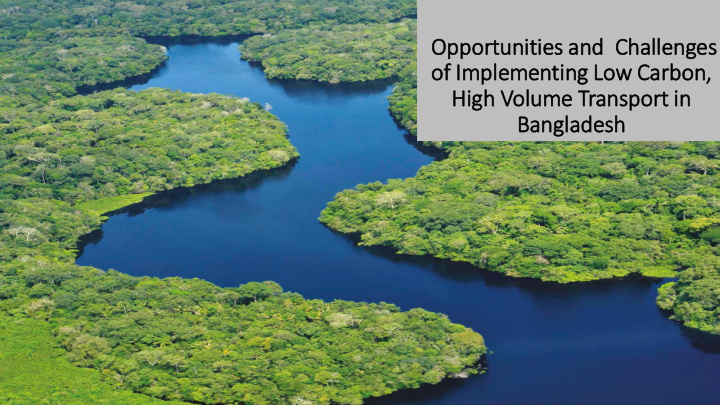



Opportunitie ies and Challe lenges of Im Imple lementing Low Carbon, , Hig igh Volu lume Transport in in Bangladesh
Objective of todays presentation • Background • Current transportation trend • Low carbon High volume transport opportunities in Bangladesh • Challenges
Background • Bangladesh is a highly climate vulnerable country with less than 0.35% of global GHG emissions • If the world fails to take ambitious action to reduce GHG emissions, the costs to Bangladesh of climate change could amount to an annual loss of 2% of GDP by 2050 and 9.4% of GDP by 2100 • Bangladesh therefore wants to play its part in global collective action to reduce GHG emissions.
Emission reduction target in NDC Sector Base year BAU scenario BAU change Unconditional Change Conditional Change (2011) (2030) from contribution Vs contribution Vs (MtCO2) (MtCO2) 2011 to scenario BAU scenario BAU 2030 (2030) (2030) (MtCO2) (MtCO2) Power 21 91 336% 86 -5% 75 -18% Transport 17 37 118% 33 -9% 28 -24% Industry 26 106 300% 102 -4% 95 -10% (energy) Total 64 234 264% 222 -5% 198 -15%
Vehicle Composition and Trend 3500000 3% 2% 3000000 6% 10% 2% 2500000 8% Bus /Minibus 2000000 3% Passenger Car Motorcycle 1500000 Microbus (Van) Jeep 66% Paratransit 1000000 Truck Pick Up 500000 0 Up to 2011 2012 2013 2014 2015 2016 2017 Total vehicle population : 3266241 2010 • Car ownership (1000) : Bangladesh - 1.8 Dhaka -15 Source: BRTA 2017
Vehicle Composition and Trend 9% 7% Bus /Minibus 7% 3% Passenger Car 17% Truck & Bus 20% 30% Microbus (Van) Car Shipping Jeep Rail & Aviation 70% Paratransit Truck 5% 23% 9% Pick Up Transport Sector CO 2 Emissionin Bangladesh Source: BRTA 2017
Vehicular emission Standard Vehicle Type As Per 1997 ECR As per 2020 2017 ECR Light duty diesel vehicles with EURO I EURO II EURO III GVW≤ 2500 kg All Cars and light duty diesel EURO I EURO II EURO III vehicles with GVW: 2500 -3500 kg Light duty Petrol and CNG vehicles with EURO II EURO III EURO IV GVW≤ 2500 kg All Cars and light duty Petrol and CNG vehicles with GVW: EURO II EURO III EURO IV 2500 -3500 kg All commercial Diesel vehicles > 3500 kg EURO I EURO II EURO III All commercial CNG vehicles > 3500 kg EURO II EURO III EURO IV Bangladesh I/II/II/IV
Fuel used in Transport Sector of Bangladesh Type of Fuel Type of Vehicle Major pollutants Comments ( consumption in 2016-17 MT) Petrol LDV PM, VOC, lead, Nox, SO2, GHG From July 1999 import of (417898) unleaded petroleum banned 500 ppm from 2016 Diesel Bus/Truck/SUV (2178171) CNG LDV/Bus/Truck/ 3 wheeler GHG (min ) Introduced in 1995 503131 nos. Veh.(2017) LPG LDV GHG (min ) Started 2016 5000 nos. LDV Electricity Passenger car/SUV “O” tailpipe emission Getting Popular
Major reasons of vehicular emission ➢ Existing HDV’s are mostly EUROI/II and use high sulfur contain diesel ( 2000-3000ppm) ➢ Existence of Old, poorly maintained vehicles ➢ Inadequate regulatory framework for inspection ➢ Congestion due to Poor traffic management
National Transport and climate change related Policy • National Integrated Multi-Modal Transport Policy 2013 • Strategic Transport Plan for Dhaka 2016 • Road master plan (2009) • Railway Master Plan (2013) • Bangladesh Climate Change Strategy and Action Plan (BCCSAP) • National Sustainable Development Strategy 2010-21 (2013) • Perspective Plan of Bangladesh 2010-2021 • Delta plan 2100
LC-HVT options for Bangladesh ( already in place) • Shift to more sustainable mode ( lower GHG emission per passenger/km) • Rail and Road based Mass transit • Restructure Bus routes • Shift to more sustainable mode ( lower GHG emission ton/km) • Enhance capacity of rail freight movement • Enhance capacity of freight movement by waterway • Shift to cleaner fuel and Technology • Reduce the sulfur level from diesel ( 50 ppm by 2023) • EURO IV by 2020 • Use of CNG both for private and public bus • Hybrid Vehicle tax incentive • More than 5 years old vehicle cant import • Demand management: Avoiding unnecessary transport trips and/or shorten length of trips with improved land use planning • Use of ICT to reduce travel ( national level/ local level) , Car free day/street • Reduce school trips by reserving 40% seat for local resident
LC-HVT options for Bangladesh ( already in place)
LC-HVT options for Bangladesh ( to be done ) • Expansion of mass transit network in Dhaka and Initiate in other major cities • Electric vehicle ( private and public) • Multimodal integration • Green freight including eco-driving • 10 ppm or less Sulfur level • Investment in charging station • Trained Manpower for maintenance • More incentive for Hybrid and electric vehicle • E- vehicles for Government • Upgrade 2 lane to 4 lane, Intersection development & SMV lane on Major Highways • Emissions graduated tax
Challenges for LC-HVT • Lack of inter-Ministry coordination ( Transport/Environment/Energy/Commerce/Shipping /Railway etc..) • Need Strict law and enforcement for adulteration • Need dedicated supply of low sulfur diesel • Lack of awareness of people about air pollution • Need huge investment to develop I/M centers • Inadequate skills, capacity, or knowledge regarding LCT • Absence of regulatory framework
Thank you
Recommend
More recommend